The cream colored CJ-5 might have some Hub Lok hubs like these, but I can’t tell for sure.
https://www.facebook.com/marketplace/item/432482847504481/
“2 jeep Exter engine extra black out headlights and tail lights”
The cream colored CJ-5 might have some Hub Lok hubs like these, but I can’t tell for sure.
https://www.facebook.com/marketplace/item/432482847504481/
“2 jeep Exter engine extra black out headlights and tail lights”
UPDATE: **SOLD** Was $500.
Not a whole lot of value here. It has a Cab Enclosure hardtop in poor condition and some EasyLok hubs.
“Willys jeep $500 or bo Dosent run for parts.”
Seller will consider offers. It’s too bad the vintage lettering isn’t in better condition.
https://www.facebook.com/marketplace/item/348912716047188/
“Willy’s cj2a Jeep project rolling frame. Tons of new and used parts. Must see. Make me a reasonable offer.”
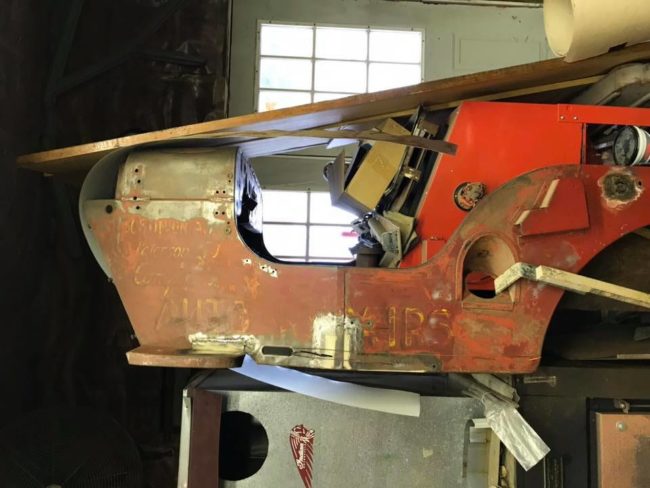
UPDATE: **SOLD** Was $400.
This appears worth a look.
“Early Jeep L Head 4 cylinder motor Motor ran when taken out Went with an F Head 134 Comes with Dana 44 427 geared rear end”
UPDATE: **SOLD** Was $20/cap
Some late 1940s/early 1950s hubcaps and, possibly, some late 1950s/early 1960s Surrey (or they could be Aero auto) hubcaps.
“$20 per hubcap or $150 for all”
UPDATE: Still Available.
(04/23/2020) The jeep comes with some new parts.
https://www.facebook.com/marketplace/item/452564425641246/
“Selling my 1951 jeep CJ3A project. I bought this with the intentions of doing a complete restoration but life has since gotten in the way. The jeep comes with all new suspension, and shocks as well as brand new bumpers and transmission crossmember, the transmission is good as well as the axles and differentials, the engine is unknown but complete. It also comes with a “new” used frame in amazing shape. This is a perfect winter project for a restoration as it is all there.”
More hubcaps.
https://www.facebook.com/marketplace/item/3105519666370477/
“These are 10 3/4″ from outside measurement. Price is per cap. Heavy weight for a hubcap. I will ship Ships from Harwich,MA PayPal and Venmo accepted as friends and family”
Just a few posts today, but some good ones!
I’ve been very interested in the Hudson Hornet Steering Modification since I heard about it a decade ago. Unfortunately, there’s scant information about implementing the modification, but reports were that it was a relatively easy one that produced fantastic results, offering a power-assist feel to the steering and reducing play (a similar, alternative steering modification is the use of a 1980s Ford Ranger box, which Lawrence Ellliot shared back in 2018).
Now, thanks to Adam, we have some new insights into the obstacles and benefits of installing a Hudson unit into a vintage jeep! Perhaps the most difficult obstacle to overcome is locating the steering box itself! Adam’s provided some great details below, but If you want to ask Adam more questions directly, he’s offered his email ahedgcock @ gmail.com (remove the spaces around the @).
Below, Adam shows some of the differences between the Hudson and Ross (Willys) units:
Here’s Adam’s description:
Hudson Horney Box casting number 34641.
John recently rebuilt a set of Cutlas Selective Hubs, the type with the knob that rotates to engage and disengage the hub. There appear to be at least two styles of these hubs, one with a flat top and one with a groove, so that a tool (or improvised tool) can be used to help engage, disengage the hub.
This exploded overview from 1961 shows how the parts assemble (see the full brochure below this post):
As you can kind of see from this diagram, there are two sections: 1) is the hub cap that holds the knob and the spring in place (from part 107-2 in the middle and everything to the right of it) and 2) the hub base (part 108-2 and everything to the left of it).
John wrote, “Overall I’d say these are my favorite hubs I’ve worked on so far. I have a pair of Warn hubs (with the tiny needle bearings) and a pair of Selectro hubs (big chrome knob type). The Warns seemed like a real pain to rebuild since the needle bearing were in rough shape. And the Selectro hubs, while very easy to operate, were probably the weakest design I’ve seen.”
Here’s a look at John’s finished product, as it’s the best example a complete hub next to a hub with the top separated from the base:
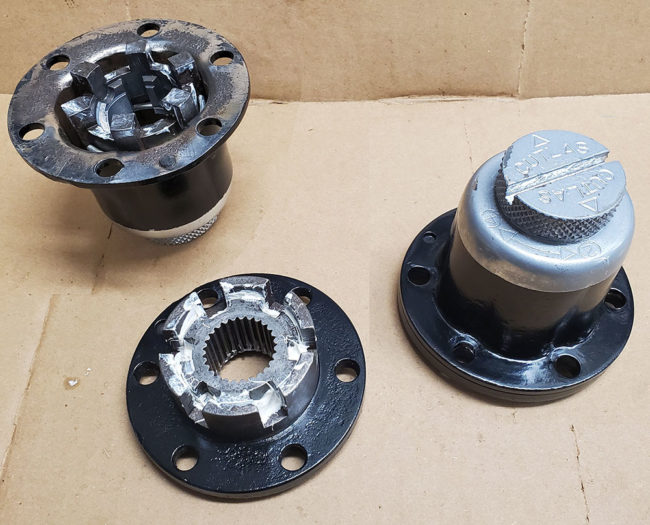
I went with a 2 tone paint job just for fun. If it doesn’t last for any reason I’ll end up with the whole thing gloss black and a chrome knob. The body was so badly pitted there was no saving the original finish
HUB CAP:
We’ll start with the hub’s cap first. John provided the following note: “To remove the coupling piece (part 102-2 Coupling) from the chrome cap (with the cutlas knob) you have to line it up right with the correct groove, then push down firmly against the spring inside (part 110-2 coupling spring). While pushing down spin the coupling, and then the coupling spring will pop the coupling right out and its free.”
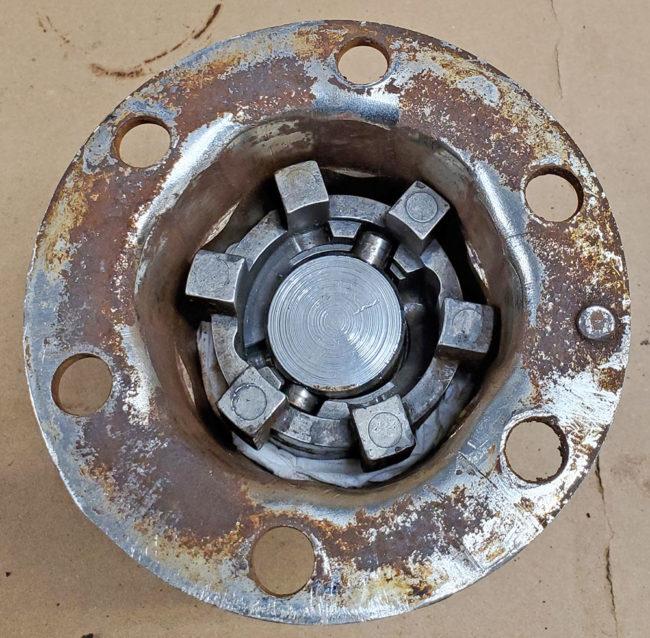
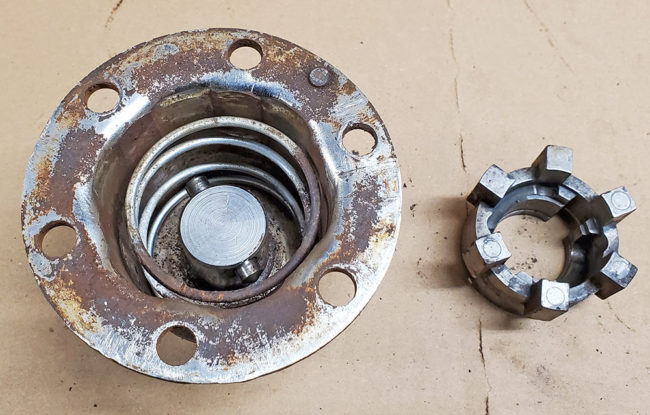
With the inner portion of the cap apart, you can see the coupling ring, the coupling, the coupling cam spring (part 107-2) and the coupling cam pins (parts 105-2).
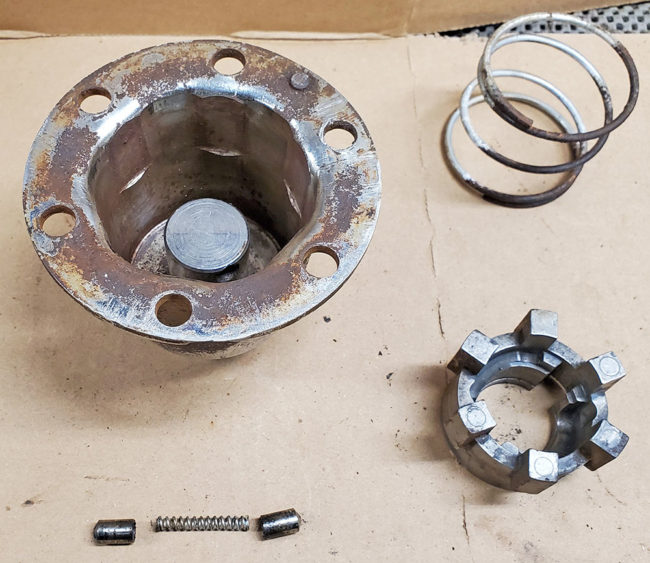
This December 1961 back-to-back brochure shows the parts break-downs and price lists for the early non-slot Cutlas Selective Hub model 100-2 and the Power Lock Hub. See John’s rebuild of the Cutlas Selective Hub here.